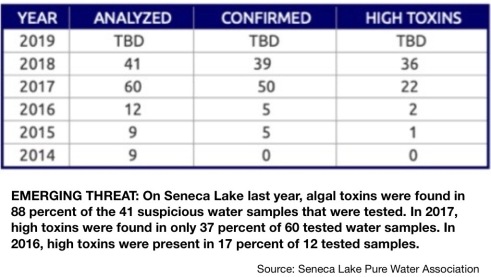SYRACUSE, July 6, 2019 — The first suspicious algal blooms of the season have been reported on Conesus, Honeoye, Otisco and Keuka lakes, although none has been confirmed with high toxins — yet.
But conditions are ripe for severe outbreaks later this summer, according to a leading regional expert on harmful algal blooms, or HABs.
“I think this is going to be a very busy year, especially with this heat spell for the next couple of weeks,” Gregory Boyer, chemistry professor and SUNY-ESF in Syracuse, said Friday.
“For HABs to develop,” Boyer added, “you need a good wet spring that puts a lot of nutrients in the lake water and that needs to be followed in the summer with a hot, relatively calm period that allows the blooms to develop. Considering that it’s 90 degrees out there now and there isn’t a breath of wind and we had a really wet spring, it’s pretty much perfect conditions for them to develop.
“They’re starting to pop up all around the state.”
The latest outbreaks can be tracked on a new interactive map provided by the state Department of Environmental Conservation. The map shows the latest suspicious blooms in the Finger Lakes and statewide, and allows citizens to photograph and report blooms to the agency. Other links show archived HABs results from previous years.
The state Department of Health provides a website listing beaches closed due to suspected HABs. Often the swimming bans are brief, and the list in constantly revised.
Generally, the DOH closes swimming areas as soon green patches are reported at or near the beaches. The agency doesn’t wait for test results that confirm the green scum contains dangerous blue-green algae, or cyanobacteria.
The DEC has a more refined protocol to respond the suspicious sightings. Water samples are tested to confirm the presence of blue-green algae, or cyanobacteria, a potent liver toxin. If they are found to have cyanobacteria they are sent to special laboratories that test the degree of toxicity.
In the Finger Lakes, microcystin is by far the most common form of cyanobacteria, although five or six others forms have also been identified, Boyer said.
A bloom is classified as “high toxin” when the microcystin concentration in the water sample exceeds 4.0 ug/L , or one microgram per liter, which is roughly 1 part per billion.
Last year on Seneca Lake, 39 of 41 blooms that were formally analyzed contained blue-green algae. Of those 39, 36 were confirmed to have high toxins. The vast majority of those came in the late summer months of August and September.
A year earlier, only 22 of 60 analyzed samples had contained high toxins.
For Cayuga Lake, the Community Science Institute operates a water testing lab and provides an up-to-date interactive map of HABs reports and test results for Cayuga Lake.
Officials responsible for public drinking water in Syracuse, which is drawn unfiltered from Skaneateles Lake, are so concerned about future HABs blooms that they are planning to spend millions of dollars to extend their water intake pipe further and deeper into that lake.
As of July 6, the interactive DEC map showed suspicious blooms on only three of the Finger Lakes: Conesus, Honeoye and Otisco. The DOH has not closed swimming areas on any of them.
While the DEC map does not show any suspected HABs on Keuka Lake, the DOH has ordered the closing of the Red Jacket Park swimming area at the northern end of that lake.
The DOH also temporarily closed the Lakeland Park Beach in Cazenovia on Cazenovia Lake and the swimming area on Quaker Lake in Alegheny State Park due to suspected HABs.
Cazenovia Lake is roughly 20 miles east of Otisco Lake, the easternmost of the 11 Finger Lakes. Quaker Lake is south of the Finger Lakes.
The beach closures were expected to extend through the July 4 weekend.


Hi Peter,
Thanks for this informative article. We will be visiting Dr. Boyer’s lab next week to get our Manta+35 fluorosensors calibrated.
Great news that Greenidge has agreed to abide by EPA regs at Lockwood.
Best, John
On Sat, Jul 6, 2019 at 11:48 AM Water Front- Peter Mantius wrote:
> Peter Mantius posted: “SYRACUSE, July 6, 2019 — The first suspicious algal > blooms of the season have been reported on Conesus, Honeoye, Otisco and > Keuka lakes, although none has been confirmed with high toxins — yet. But > conditions are ripe for severe outbreaks later this sum” >
LikeLike